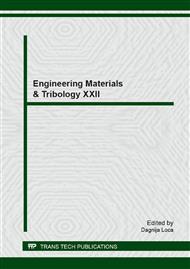[1]
L. Yan, N. Chouw, K. Jayaraman. Flax fibre and its composites – A review, Composites: Part B 56 (2014) 296-317.
DOI: 10.1016/j.compositesb.2013.08.014
Google Scholar
[2]
Z. Jankauskienė, E. Gruzdevienė, A. Endriukaitis. Sėjamųjų kanapių auginimo technologija, Lietuvos žemdirbystės institutas, Kaunas (2007).
Google Scholar
[3]
H. -R. Kymalainen, A. -M. Sjöberg. Flax and hemp fibres as raw materials for thermal insulations, Building and Environment 43 (2008) 1261-1269.
DOI: 10.1016/j.buildenv.2007.03.006
Google Scholar
[4]
J. Zach, J. Hroudova, J. Brožovsky, Z. Krejza, A. Gailius. Development of Thermal Materials on Natural Base for Thermal Insulation Systems, Procedia Engineering 57 (2013) 1288-1294.
DOI: 10.1016/j.proeng.2013.04.162
Google Scholar
[5]
E. Mažonienė, J. Bendoraitienė. Pluoštai, Vilniaus pedagoginis universitetas, Vilnius (2008).
Google Scholar
[6]
H. -R Kymäläinen, M. Koivula, R. Kuisma, A. -M Sjöberg, A. Pehkonen. Technologically indicative properties of straw fractions of flax, linseed (Linum usitatissimum L. ) and fibre hemp (Cannabis sativa L. ), Bioresource Technology 94 (2004) 57–63.
DOI: 10.1016/j.biortech.2003.11.027
Google Scholar
[7]
I. Baltina, Z. Zamuška, V. Stramkale, G. Strazds. Physical Properties of Latvian Hemp Fibres, Environment Technology Resources, (2011).
DOI: 10.17770/etr2011vol2.964
Google Scholar
[8]
EN 12667: 2002. Thermal performance of building materials and productions – Determination of thermal resistance by means of guarded hot plate and heat flow meter methods – Products of high and medium thermal resistance.
DOI: 10.3403/02109602
Google Scholar
[9]
S. A. Aivazyan, Statistical analysis of dependencies, Application of correlation and regression analyses and processing of experimental results, Menallurgy, Moscow, (1968).
Google Scholar
[10]
E. J. Williams, Regression analysis, John Wiley and Sons Sydney, New York, London, (1959).
Google Scholar
[11]
Information on https: /www. statsoft. com/Textbook.
Google Scholar


